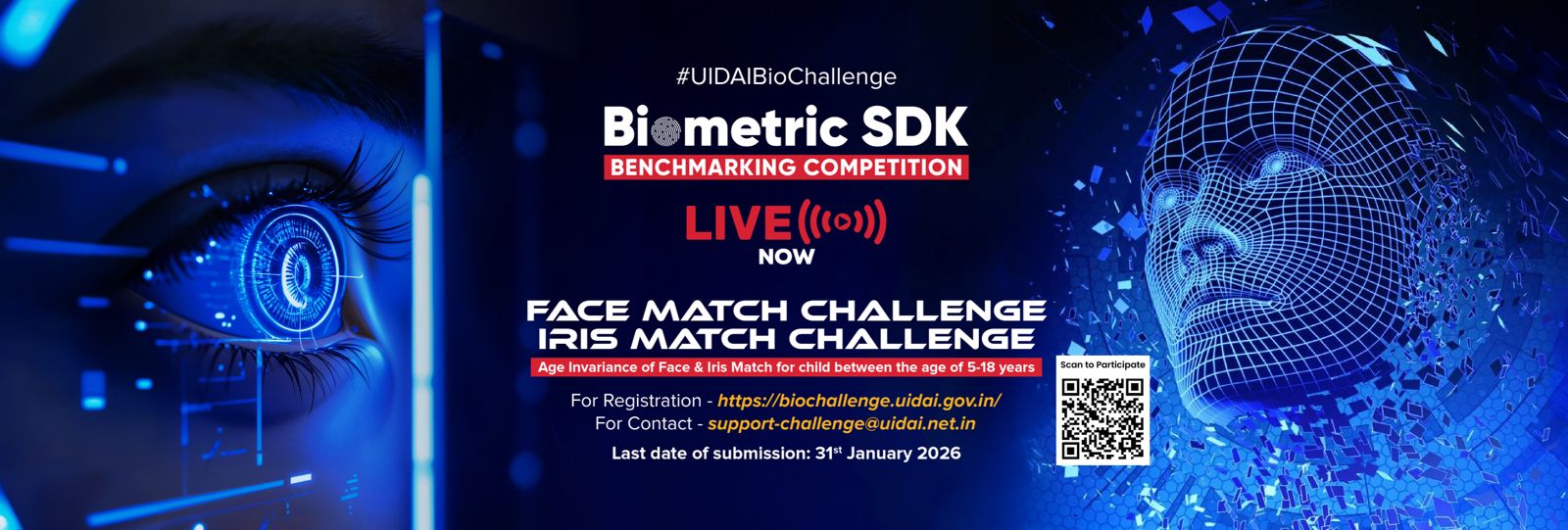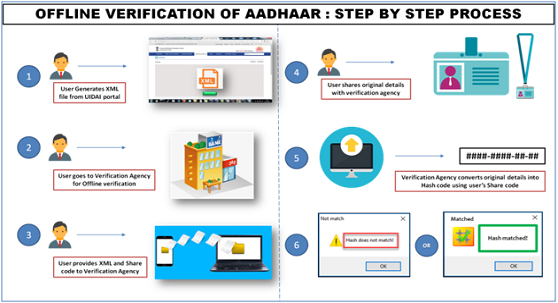What are the UIDAI Guidelines for Biometric Data Capture?
Biometric Data Capture Guidelines:
Check applicant's eyes and fingers for fitness (missing/amputated). If the applicant has any deformities due to which it is not possible to take fingerprints/iris, these also have to be captured as a biometric exception.
Check and indicate Biometric Exceptions in the software, only where applicable. Do not mark biometric exceptions where biometrics can be captured. It will be treated as ‘fraud’ and invite strictest penalty.
In case of Biometric exception, always take the Exception photograph of the applicant showing individual’s seeking to enrol/update face and both hands, irrespective of the type of exception.
The enrolee may not be in a position to keep herself / himself in correct posture for reaching biometric instruments or for photograph due to old age or sickness. In such cases the operator should arrange to take the biometric data by moving the equipment close to the enrole.
If the finger/iris of the applicant has a temporary damage and it is not possible to capture the biometric, the applicant should come later once temporary damage is resolved.
Capture Biometrics - Facial Image, IRIS and Fingerprints for all the applicants above 5 years in age.
In case of children who are below 5 years in age, only Facial Image and authentication by one of the parent’s/legal guardian is to be captured.
Guidelines for Facial Image Capture
Enrolee Position: For capturing facial image, it is advisable for the operator to adjust the camera instead of the Enrole to position herself/himself at the right distance or in the right posture. Frontal pose needs to be captured i.e. no head rotation or tilt. The applicant should be instructed to be seated properly with their back upright and their face towards the camera.
Focus: The capture device should use auto focus and auto-capture functions. The output image should not suffer from motion blur, over or under exposure, unnatural colored lighting, and distortion.
Expression: Expression strongly affects the performance of automatic face recognition and also affects accurate visual inspection by humans. It is strongly recommended that the face should be captured with neutral (non-smiling) expression, teeth closed, and both eyes open and looking into the camera.
Illumination: Poor illumination has a high impact on the performance of face recognition. Proper and equally distributed lighting mechanism should be used such that there are no shadows over the face, no shadows in eye sockets, and no hot spots. No light exactly above the enrolee should be used since it can cause shadows. Light should be diffused and placed in front of the enrolee so that there are no shadows under the eye.
Eye Glasses: glasses should be taken off before taking the photograph.
Accessories: Use of accessories that cover any region of the face is not permitted. For example, women in purdah would have to reveal the full face before the photograph is taken. Similarly women in Ghoonghat would have to clearly reveal the full face before the photograph can be captured. The head may remain covered but the full face contour should be visible.
Further, accessories like turban/head gear are also allowed as religious/ traditional practices.
However, accessories like eye patches are allowed due to medical reasons. This would also mean an exception needs to be recorded for Iris, because only one Iris can be captured.
Operators need to be trained to obtain the best possible face images that satisfy requirements. Even if the quality flag is green but the Operator is able to judge that a better picture can be taken, then same should be attempted. However, it should be borne in mind that recapture should not become harassment for the applicant.
For children, it is acceptable that the child sits on parent’s laps, but it needs to be ensured that parent’s face is not captured along with child’s face. The background may get rejected due to non white screen in case of children but two faces should not get captured in one picture.
Actionable feedback needs to be checked for captures that fail. Some of the actionable feedbacks in software are:
No face Found
Enrolee too far
Enrolee too close (eye distance in input image is greater than one third of image width)
Pose (Look Straight)
Insufficient lighting
Very low face confidence (faceless, object not identified as human face)
Non-uniform lighting (of face in output image)
Incorrect background (in output image)
Insufficient lighting (bad gray values in face area of output image)
If any biometric exceptions have been specified on the demographic screen, these should be captured as photographs on the Photograph screen.
Only facial image is captured for children below 5 years. Iris and fingerprint screens will not get activated for children below 5 years
Guidelines for Capturing Fingerprints
The images of all the ten fingers are to be captured. The fingerprints must be captured in the sequence of slaps of four fingers of left hand, right hand followed by the two thumbs.
The fingers have to be positioned correctly on the platen to enable capture. There should be no direct light shining on the platen. Use the Indicators on fingerprint devices for positioning of fingers. The fingers should be placed in right direction on the device. Please consult the manufacturer manual incase of any doubt or else consult the supervisor.
Use a lint free cloth periodically to clean the platen of the finger print device for good finger print capture
Check devices periodically for scratches, out of focus images, only partial images getting captured. In case any such problem is noticed, then report to your Supervisor/EA and request for change of equipment.
Fingerprints cut off, wet/smudged fingerprint; very light prints due to insufficient pressure will result in poor quality. The applicant's hands should be clean (no mud, oil etc.). Ask applicant to wash hands with water and soap, if necessary.
The fingers should not be excessively dry or wet. Moisten with a wet cloth or dry finger with a dry cloth
The Enrollee should be requested to place all four fingers of the left hand/right hand/two thumbs to platen of the fingerprint scanner for the four-finger capture to ensure good contact and maximize the area of the captured fingerprints. Ensure that the fingers are placed flat and till the top joint of the finger is placed well on the scanner. The top of the fingers should be within the platen area and not outside the defined area.
If automatic capture does not happen, the operator should force the capture when force capture tab is enabled in the enrolment software.
The operator should check the actionable feedback when capture fails. Some actionable feedbacks provided by software are:
Number of fingers present does not match with expected number of fingers
Finger not positioned correctly
Too much Pressure (duty cycle)
Too little pressure
Central region missing
Excessive moisture (wetness)
Excessive dryness
The operator should visually check the image for quality and for typical problems. In case there are problems go back to steps above to retry the capture.
When image quality is pass or if maximum number of captures are exhausted, move on to the next step
Fingerprints are best captured in standing position
In case of additional fingers, ignore the additional finger and capture the main five fingers.
Make sure your own fingerprints do not get mixed with the applicant's fingerprints. Operators can carefully put small pressure on the applicant's fingers to capture the fingerprints but always make sure not to mix your own fingerprints.
Guidelines for Capturing Iris
The operator and not the Enrollee will handle the capture device, generally.
Children can be told that it is like taking photos/pictures so that they are not apprehensive.
The Enrollee will be required to sit in a fixed position, like taking a portrait photograph.
The software is able to measure the iris image quality. An initial image quality assessment would be done to provide feedback to the operator during the capture process. The software alerts the operator with actionable feedbacks, if the captured iris image is of insufficient quality. Some actionable feedbacks provided by software are:
Occlusion(significant part of iris is not visible)
Iris not in focus
Gaze incorrect(individual seeking to enrol/update looking away)
Pupil dilation
The iris capture process is sensitive to ambient light. No direct or artificial light should directly reflect off Enrolee’s eyes.
The device should be held steady. In case device requires to be held by individual seeking to enrol/update, the enrolment operator/supervisor may help the applicant to hold the device steady.
Table light used for facial image capture should be switched off during iris capture. Direct sunlight or any other bright light shining on applicant's eye will create reflections and result in poor quality image.
Operator must instruct the applicant to look straight into the iris scanner, open eyes wide open (one easy way to do this is to ask the applicant look angry or stare) and do not blink during iris capture. Applicant has to be stationary.
If applicant is experiencing difficulty during Iris scan and recapture is required, then the operator may navigate to next screen to capture other details and then return to Iris capture. This will relax the applicant from constant pressure to keep eyes wide open during iris capture.
The Operator needs to be patient during capture and wait for the device response instead of scrolling, navigating back and forth on screen.













 play_circle_outline
play_circle_outline


